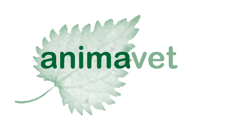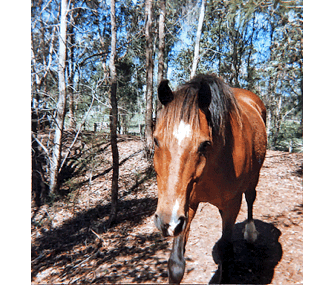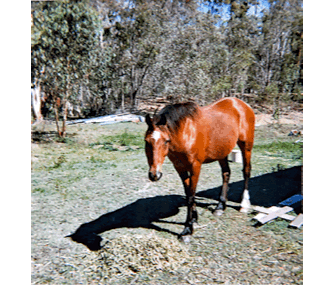
animal health consulting
Equine Cushing's disease
and the sense of belonging
Christine King BVSc, MANZCVS (equine), MVetClinStud
When I get a moment, I'll write an in-depth article on the pathophysiology of equine Cushing's disease (ECD), also known as pituitary pars intermedia dysfunction (PPID). (It's a fascinating topic, but rather heavy on the biochemistry... You're welcome :-) Here I want to talk about the metaphysical aspects of the disease, meta- being a Greek word root I'm using to mean 'along with' or 'alongside'.
In my experience, an essential component of ECD is chronic social stress — in particular, a chronic lack of belonging. Another way of saying that is loneliness, but I prefer to focus on what's needed, which is a sense of belonging, because therein lies the solution.
While a lack of belonging may not cause ECD on its own, it's certainly a contributing factor in the development and progression of the disease, and an element that's often missing from the conventional approach to treatment ('hormone replacement therapy' using pergolide, cabergoline, or other dopaminergic compounds).
Horses are a social species. In their natural setting, wild or feral* horses live in small herds or 'bands', consisting of one stallion and several mares, along with their young (foals, weanlings, and yearlings). Weaning is typically a relaxed affair that occurs gradually and by mutual agreement sometime between 6 and 12 months of age. As the foals grow up, the fillies either stay in their 'native' herd or they go off and join another herd; the colts leave the herd, aspiring to have one of their own at some point and living together in 'bachelor bands' (all-male herds) in the meantime.
* Feral horses are free-living horses who were once domestic horses or who are descended from those who were once domestic horses. For example, Australia's brumbies are all descended from horses brought here by European settlers. Horses are not native to Australia, so we have no wild horses, as such; brumbies are properly called feral horses — although 'wild' sounds much more romantic :-)
For all that, herd life is not as idyllic as I may have made it sound. Equine interactions are often very physical, and there is plenty of fighting, particularly among the males; and for many free-living horses, the wild life is arduous and dangerous.
However, the key element here is that horses are never on their own for very long. Even today, in countries where large carnivores (bears, big cats, wolves) are found, solitary horses are easy prey for predators, and this ancient vulnerability reverberates in every horse's DNA. Togetherness is an essential survival strategy for horses, so it underpins their sense of physical and psychological (mental/emotional) well-being.
Social stresses
Given how most domestic horses are kept, it's no surprise that stress-associated medical and behavioural problems are common. Here are the most common causes of social stress in horses:
isolation — keeping horses separated from each other, keeping just one horse, preventing horses from even seeing other horses, etc.
repeated disruption of social bonds — moving horses from place to place through sale or lease, relocation, boarding for training, travel for events, etc.
incompatible company — keeping horses together who don't like each other, mixing horses who don't know each other yet are expected to get along, etc.
bullying — bullying is a sign of systemic disorder in a herd; the entire group is stressed by bullying, not just the horses who are lowest on the 'pecking order'
confinement — even in a barnful of horses, being confined to a stall or small paddock is stressful for a species designed to roam as a herd over vast areas of territory
The common thread is one of not feeling a sense of belonging or not being able to trust a sense of belonging because there is no control over one's social situation, which may change at any time.
OK, but why would ECD be a disorder of belonging?
ECD and belonging
Unlike Cushing's disease in humans and dogs, which is caused by a benign tumour in the pituitary gland (most common) or in one of the adrenal glands, the epicentre of the disease in horses is the hypothalamus — an area in the base of the brain that has been described as "the seat of emotion."
Like the common form of Cushing's disease in other species, the pituitary gland in horses with ECD becomes enlarged (although not by a tumour) and overproduces the hormone that directs the adrenal glands to secrete cortisol, a "stress" hormone. However, the problem in horses with ECD originates not in the pituitary gland but in its master gland, the hypothalamus.
The biochemical processes involved are intricate and not what I want to focus on here. But I remember being struck when I realised that the specific pathology (dopaminergic neurodegeneration) in the hypothalamus of horses with ECD is identical to that in humans with Parkinson's disease; it just happens in a different part of the brain (nearby, but functionally quite separate).
In Parkinson's disease, the main pathology involves physical agency (control over one's movement). Given the role of the hypothalamus in our experience and expression of emotions, might the main pathology of ECD be described as involving social agency (control over one's social connections or emotional well-being)?
My own horse
I first made the connection between chronic social stress and ECD with my own horse. Banjo was my first horse. We'd had horses and ponies for as long as I can remember, but I'd never had one of my own. When I was 15, I worked all summer in a factory and finally earned enough money to buy my own horse just before school started for the year.
Banjo was an Australian stock horse gelding. He had one white sock, and like the horseman's adage says, I kept him "till the end."
If you have a horse with four white socks, send him far away.
If you have a horse with three white socks, keep him for a day.
If you have a horse with two white socks, give him to a friend.
If you have a horse with one white sock, keep him till the end.
Banjo was 7 years old when I got him, and he remained with my family until he died at 32 years of age.
When he first arrived, Banjo and my sister's pony, Reilly (a Welsh mountain pony who'd long been in residence here), fought for several months over who would lead their little herd of two. Reilly eventually won, and peace reigned. The two became inseparable — or, I should say, that Banjo was inconsolable if Reilly went out on a ride without him, and he would not stop running the fences and calling out until Reilly returned.
In hindsight, that's a critical piece. "Herd-bound" horses are not suffering from an excess of bonding, but from a lack of stable social bonds or a lack of trust that the bonds they do have will hold (or will be honoured by us). Typically, horses are moved around many times throughout their lives, and they seldom get to remain in the same herd or stable social group for their entire lives. Some horses adapt well to these sudden changes in their social network and sudden breakage of the social bonds they've formed; others do not.
(I'm thinking I should write an article or perhaps an e-book on the highly sensitive horse, to go along with the one on the highly sensitive dog...)
I don't know anything about Banjo's 'formative' years, but I do know that he'd been born and raised on a station (Aussie term for ranch) outside of Biloela in central Queensland, and he ended up being sold by a horse trader in Brisbane, over 500 km from where he was born. There's more than enough there for the fertile imagination...
Eight years later, when Reilly died and was buried in the back paddock, Banjo didn't make a sound. He stood silently over Reilly's grave for about a week. My sister didn't want another horse after Reilly died, so Banjo became an only-horse and remained so until he died, 17 years later. My sister kept goats instead, but eventually they too were phased out, leaving Banjo completely alone here except for his human caretakers. None of our neighbours had horses or other livestock, so it was a solitary existence for the latter part of his life.
After I graduated from vet school and moved away for work, I intended to relocate Banjo to where I was living, but by the time I felt settled enough, Banjo was a senior horse and I didn't think the long trip from Queensland to Victoria (where I was working at the time) was wise, so he stayed put.
Staying put was a good thing for him, but knowing what I know now, I'd have made sure he had another horse or pony for company — and made sure it was someone he really liked.
Because somewhere along the way, Banjo began showing the classical signs of ECD, most notably the long, shaggy haircoat that was never shed in the spring. I've since seen any number of horses with ECD whose social situations I'd describe as "less than ideal." Whenever their person has been able to improve the horse's social situation by ensuring compatible company in a stable 'herd' (even if only a herd of two), the disease has been far easier to manage. And whenever I can intervene early enough in the process, the disease is reversible.
ECD may be preventable
If I'm right, then this disease may also be preventable. We used to think that, as ECD is a disease of old horses, every horse would develop pituitary gland dysfunction if s/he lived long enough. But those assumptions have been debunked. Equine Cushing's disease is not just a disease of old horses; while most horses showing signs of ECD are in their late teens or older, ECD has been diagnosed in young adult horses. In addition, not all senior horses develop ECD nor even any laboratory evidence of pituitary dysfunction. Only some horses develop ECD.
Why only some horses, and why them?
No doubt, genetic predisposition and management factors are the two big players. Within 'management' as a category, diet is hugely important.
The microscopic lesion associated with ECD appears to be caused by chronic oxidative damage to the dopamine-secreting nerve cells (dopaminergic neurons) in the hypothalamus that control the intermediate part of the pituitary gland (the pars intermedia). So while the pathology is described as dopaminergic neurodegeneration, it is also described as oxidative neurodegeneration. A diet rich in antioxidants is an important component of both prevention and treatment. I have a lot more to say about dietary management, but that's for another time.
An equally important component of 'management' is housing and turnout, particularly whether horses are kept separate or in groups, and whether those groups are stable and congenial or often-changing and often contentious.
Although few of us want to keep horses in an entirely natural way (roving band of stallion, mares, and their young offspring), the closer we can get to the core element — belonging to a stable, compatible group — the healthier our horses will be.
Life is characterised by change. Our lives will always include comings and goings, and occasional discord; the same is true for our horses. But change is far less disruptive and distressing when we enjoy a solid sense of belonging.
Simply by realising our horses' elemental need for each other and by respecting the social bonds they've formed with each other, we'll do a far better job of serving their interests and meeting their needs. Then it's far easier to get and keep them healthy.
© Christine M. King, 2020, 2022. All rights reserved.
First published on WordPress, 11 Nov 2020.

Banjo in his younger years.
I named him after the famous Australian bush poet, Banjo Patterson, who wrote The Man From Snowy River and Walzing Matilda, among many other notable poems and stories.

Couldn't resist throwing in another. I just love that beautiful boy!